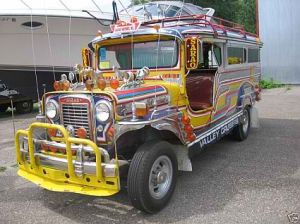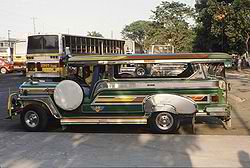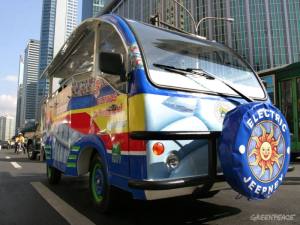They get hot and smoky from the hugely polluting engines; they can be uncomfortable and completely unsuitable, but if anyone tried to take them away, I think there would be an uproar.
Much has been written about the history already about the famous cultural icon of the jeepney so I wont waste words going over information already available.
They take you to every corner of the capital using side roads as well as main highways. They have routes but as a new visitor here, its doubtful you will be able to work them out alone. You can try asking people, but it’s not easy; you definitely need some local geography knowledge.
Riding a jeepney is yet another insight into the Filipino and their everyday world and where you are likely to encounter friendly conversation and witness the patience of the locals. They are hot with often open windows meaning you get a full taste of the pollution. They are cramped with little distance between floor and ceiling. Until you get used to them, you are likely to bang your head as you bent over to move down the jeepney to an empty seat and again as you get off.
They represent a battle between traditional and progress and up to now the traditional is still winning. As much as they have charm, history and being a part of the culture, it could also be said that they are totally unsuitable in almost every imaginable way as a modern public transport vehicle.
The other side of their popularity is simply because they are the cheapest way to travel. The fare starts at 8 pesos and you can get quite far for that amount with small increases as you travel further. This is why they are many people’s choice of public transport as affordable they most definitely are.
 Things have improved as when I first visited here around 8 years ago, almost every jeepney I saw was belching out huge amounts of black smoke from old and unmaintained engines. Then the previous administration introduced legislation which meant they had to have exhaust omissions tested as a way to curtail the worse pollution offenders. The progress was slow, but over the years I’ve noticed a great improvement when it comes to smoke belching jeepneys on the road. Now 2013, I don’t see many so its been a success.
Things have improved as when I first visited here around 8 years ago, almost every jeepney I saw was belching out huge amounts of black smoke from old and unmaintained engines. Then the previous administration introduced legislation which meant they had to have exhaust omissions tested as a way to curtail the worse pollution offenders. The progress was slow, but over the years I’ve noticed a great improvement when it comes to smoke belching jeepneys on the road. Now 2013, I don’t see many so its been a success.
However, they are still heavy polluters in an already over-polluted capital. Other negative, and for me the biggest reason I believe them to be totally unsuitable is that you have no idea where you are if you’re in unfamiliar territory. The windows are low making it difficult to see out of as well as being too small. I often struggle knowing where I am as I can’t see anything, far from ideal for a public transport vehicle. They have a row of bench seats facing each other which further compounds the visibility problem as other passengers also obscure the low windows and it really is a challenge.
A good tip is, if possible, take the front seat alongside the driver if you are lucky enough to find it available. Unfortunately though, the vast majority of times they are already taken as others have the same thinking.
They operate in every part of the Philippines and if you are in an area not served by one or at least close by, then you are certainly somewhere very remote indeed. They really are unique and have been kept going for decades now and are the lifeblood of commuters, shoppers, school and college students the whole country over.
Although most people simply keep to themselves on a jeepney, I have had many a friendly exchange riding one of these crazy people trucks. The nature of the seating means you are sat facing each other and I’m often smiled at as eye contact and close human interaction is unavoidable which is all part of the charm of the jeepney, a small compensation for the slight discomfort of being on a crowded one.
Now, Metro Manila citizens are often at their worse as commuters on many forms of public transport. In most situations, involving crowds or commuting, some have a tendency to queue jump and conveniently pretend they never noticed any queue and go straight to the front. Many will barge and push to get on the bus or train to the extent you feel the urge to scream, but for some reason, the jeepney brings out the best in the Filipino. You don’t witness this kind of behaviour much when riding a jeepney. You see a rare thing as regards interactions between people here which is a little more inspiring.
 They are a little dangerous in so much as the driver has a lot to contend with making him prone to accidents but they are sturdy enough to suggest you would probably survive it should it happen. The poor old jeepney driver has a hard enough time driving that heavy old thing through some of the world’s craziest traffic, then having to stop when someone shouts “Para (stop)” or bangs a coin on the steel handrail as well as managing to pick up passengers.
They are a little dangerous in so much as the driver has a lot to contend with making him prone to accidents but they are sturdy enough to suggest you would probably survive it should it happen. The poor old jeepney driver has a hard enough time driving that heavy old thing through some of the world’s craziest traffic, then having to stop when someone shouts “Para (stop)” or bangs a coin on the steel handrail as well as managing to pick up passengers.
At the same time, he has to collect the fares. This adds to the danger as he does so by putting his hand over his shoulder for passengers to give him their fare, he then sorts out the change usually from a tray he keeps in the front and the hand goes back over his shoulder to give to the passenger, all whilst his still driving along.
This is when you see a remarkable unofficial arrangement between driver and passenger, which is built on trust and cooperation. People virtually supervise it themselves passing the fare down the jeepney from hand to hand and the goodwill and honesty of the passengers are what gets the driver through.
Be prepared to pass others’ money down the jeepney to the driver with a “bayad daw (meaning here’s someone’s money)” or “bayad po (here’s my money)” and also return the change from hand to hand. It’s a rare moment of cooperation with the people and driver and good to see.
I’ve been told that in the past, jeepneys were far more elaborate, and were the objects of some amazing works of art. By all accounts, that seems to be more of a bygone age. These days, what are sometimes featured are references to various countries which could include a national flag on a door or side mirror or other references to a particular country. I used to wonder why that was and I’m told that it’s a kind of homage to the place where a relative, or perhaps themselves managed to work to earn the cash to buy the jeepney.
The jeepney still possesses a certain charm, and you see signs of what they used to be. Although it’s not as common these days, you do occasionally see some fantastic jeepney art painted on a jeepney. It really would be nice to see more of them but it seems those times are past.
In all honesty, they really need to re-think the jeepney; a more unsuitable vehicle for public transport would be hard to find anywhere. But I think as with many things, they are simply used to it accept it which is very much a Filipino trait.
Sadly, they are rarely as elaborate as these but they have their own story which is why they are regarded as such a cultural icon here.
In truth, they really do need a rethink as a modern-day public service vehicle when the world is trying to improve the environment and the visibility aspect definitely needs looking at. What good is public transport that you cannot see out the windows of. Electric jeepneys may be the future although the traditionalists would be dismayed, but somehow I think they have to be considered. In fact there is now an electric jeepney service in Makati.I just wish if they are not going to upgrade them, then at least keep up the tradition of the finest vehicle art you will see anywhere. Unfortunately, maybe due to the usual lack of cash, they are not what they used to be.
I’ve heard that in Cagayan De Oro in Northern Mindanao, the artwork is still much in evidence. I will let you know how true that is if I ever get there.


Pingback: Jeepneys in the Philippines